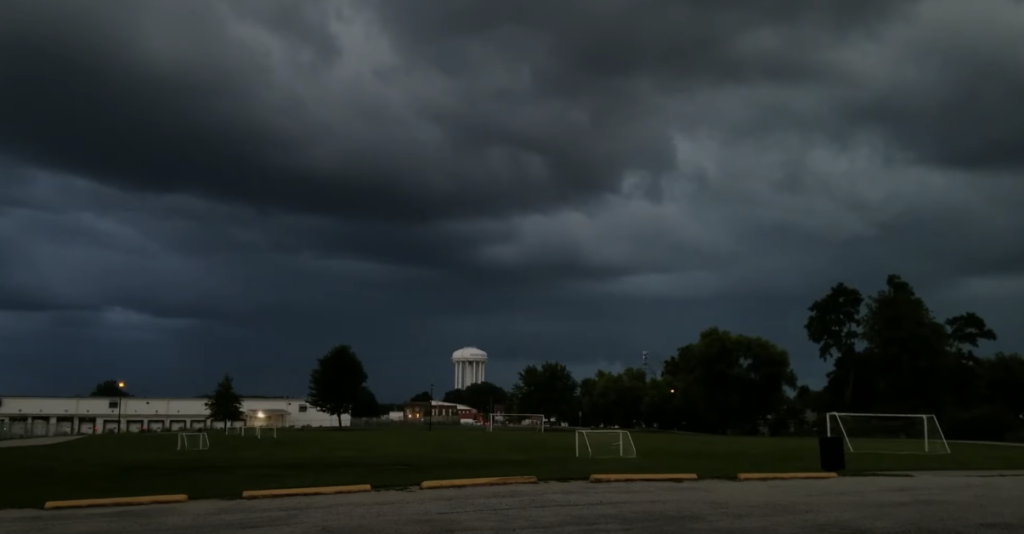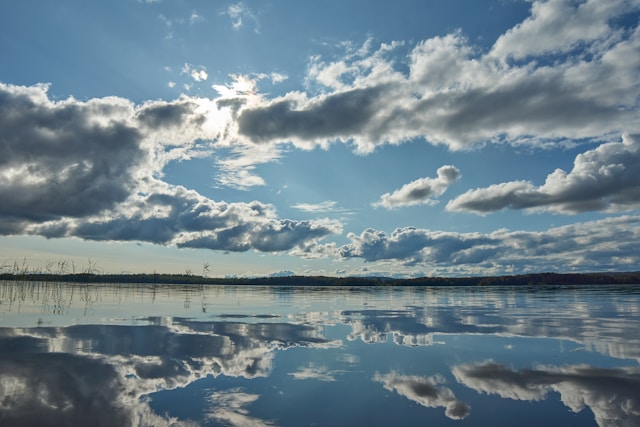Cold fronts play a crucial role in shaping weather patterns worldwide, exerting a significant impact on atmospheric conditions. These meteorological occurrences mark the transitional boundary where a colder mass of air displaces a warmer one. In this article, we will explore the intricate details of cold fronts and how they distinctly influence weather phenomena.
Understanding the Meteorological Mechanics of Cold Fronts
A cold front emerges as a boundary when a cooler mass of air displaces a warmer mass. Due to the difference in density, with cold air being denser than warm air, the colder air slides beneath the warmer air, compelling it to rise. As the warm air ascends, it undergoes a cooling process, leading to the condensation of moisture and the formation of clouds, potentially resulting in precipitation.
Distinctive Characteristics of Cold Fronts
Each cold front possesses specific characteristics that influence the weather to varying degrees, depending on the intensity of the front and the prevailing atmospheric conditions it encounters.
Temperature Change
A significant temperature decrease is a prominent feature of cold fronts, which can occur rapidly upon the front’s arrival. The extent of this shift can vary, ranging from subtle to substantial, depending on the temperature difference between the advancing cold air mass and the displaced warm air mass. The temperature alteration accompanying cold fronts is influenced by various factors, including the intensity of the front, the stability of the atmosphere, and the moisture level within the involved air masses.
Temperature Change Examples
| Temperature Difference (°F) | Description |
|---|---|
| 5-10 | Slight temperature drop |
| 10-20 | Moderate temperature drop |
| 20-30 | Significant temperature drop |
| 30+ | Drastic temperature drop |
The temperature discrepancy between the advancing cold air mass and the displaced warm air mass is classified into distinct ranges in the provided table. Each range is associated with a description that characterizes the extent of temperature decline encountered when a cold front passes through.
Factors Influencing Temperature Change
- Strength of the Cold Front: The strength of a cold front contributes to determining the degree of temperature alteration. A more potent cold front typically induces a more pronounced decrease in temperature, in contrast to a weaker front;
- Atmospheric Stability: The stability of the atmosphere plays a crucial role in influencing the temperature variation during a cold front. In an unstable atmosphere, the temperature drop can be more noticeable due to convective processes, whereas in a stable atmosphere, the temperature change may be less striking;
- Moisture Content of Air Masses: The moisture content within the warm and cold air masses influences the temperature variation when a cold front passes through. Moist air, with its higher heat capacity, tends to moderate the temperature drop, whereas dry air may experience more pronounced decreases in temperature.
Pressure Change
As the colder, denser air mass advances, it results in an elevation of atmospheric pressure. This rise in pressure serves as another significant characteristic of a moving cold front. The extent of the pressure alteration during a cold front passage can vary, influenced by the front’s intensity, the temperature disparity between the air masses, and the vertical composition of the atmosphere.
Pressure Change Examples
| Pressure Change (mb) | Description |
|---|---|
| +1 to +3 | Slight pressure increase |
| +4 to +6 | Moderate pressure increase |
| +7 to +10 | Significant pressure increase |
| +10 or higher | Drastic pressure increase |
The provided table showcases various ranges of pressure changes observed when cold fronts pass through. Each range is accompanied by a description that elucidates the corresponding increase in atmospheric pressure.
Factors Influencing Pressure Change
- Strength of the Cold Front: The intensity of the cold front has an influence on the magnitude of the pressure change. A stronger front typically leads to a greater increase in atmospheric pressure compared to a weaker front;
- Temperature Contrast: The temperature difference between the advancing cold air mass and the displaced warm air mass has an impact on the pressure change. A larger temperature contrast commonly results in a more notable increase in atmospheric pressure;
- Vertical Structure of the Atmosphere: The arrangement of temperature and moisture levels at different altitudes within the atmosphere contributes significantly to the variation in pressure when a cold front moves through. Changes in temperature and moisture distribution have the ability to modify the vertical gradient of pressure, thus impacting fluctuations in atmospheric pressure.
Wind Change
Prior to the arrival of a cold front, the prevailing winds typically blow towards the front, carrying warm air in the direction it is moving. However, once the front sweeps through, there is a noticeable shift in the prevailing winds, which now originate from the west or northwest in the Northern Hemisphere. This shift occurs as a result of the influence exerted by the high-pressure system associated with the cold front. In order to fully grasp the intricacies of wind dynamics during the passage of a cold front, it is necessary to examine factors such as wind direction, speed, and the accompanying weather patterns.
Wind Direction Change
| Before Cold Front | After Cold Front |
|---|---|
| Towards the front | West or northwest |
The provided table summarizes the customary shift in wind direction observed during the passage of a cold front. Preceding the front’s arrival, winds blow towards the front, while following the front’s passage, the prevailing winds frequently originate from the west or northwest.
Wind Change Characteristics
- Directional Shift: The most notable wind change that takes place during the passage of a cold front is the shift in wind direction. This shift occurs as a result of the displacement of warm air by the advancing cold air mass. In the Northern Hemisphere, the prevailing winds typically transition from southerly or southwesterly directions to westerly or northwesterly directions;
- Speed Variations: The wind speed can exhibit variability during the passage of a cold front. Prior to the front’s arrival, the winds may be relatively stronger as they transport warm air towards the front. However, after the front passes through, the wind speed tends to decrease as a result of the influence exerted by the associated high-pressure system;
- Weather Patterns: The movement of wind connected to a cold front often triggers changes in weather conditions. Once the front passes, the introduction of a drier and cooler air mass can lead to clearer skies and a decrease in cloudiness. Moreover, the alteration in wind direction frequently brings about a decline in humidity levels and a noticeable temperature decrease.
Moisture Levels
Following the passage of a cold front, the intrusion of drier and cooler air tends to result in a decrease in humidity levels. This change contributes to a fresher and less humid feel in the ambient air. Analyzing moisture levels during a cold front passage entails comprehending the alterations in relative humidity and dew point temperature.
Moisture Level Change
| Before Cold Front | After Cold Front |
|---|---|
| Higher humidity | Lower humidity |
The provided table summarizes the customary alteration in humidity levels witnessed during the passage of a cold front. Before the front’s arrival, humidity levels tend to be higher, while following the front’s passage, the introduction of drier air results in lower humidity.
Moisture Level Characteristics
- Relative Humidity: Relative humidity indicates the moisture content in the air relative to its maximum capacity at a specific temperature. Prior to the arrival of a cold front, the relative humidity may be higher since warm air can hold more moisture. However, as the cold front passes through, the influx of drier air causes a reduction in relative humidity;
- Dew Point Temperature: The dew point temperature refers to the temperature at which the air becomes saturated, leading to condensation. Prior to the arrival of a cold front, the dew point temperature may be higher, indicating a greater amount of moisture in the air. However, as the cold front passes, the dew point temperature typically decreases due to the introduction of drier air.
Cloud Formation
As the cold front progresses and encounters the warm, moist air ahead of it, the cooling effect prompts the process of condensation. This condensation process gives rise to the formation of clouds, which subsequently contribute to a range of weather phenomena. The analysis of cloud formation during a cold front passage entails a comprehension of the types of clouds that may develop and their corresponding characteristics.
Cloud Types Associated with Cold Fronts
| Cloud Type | Description |
|---|---|
| Cumulus | Puffy, white clouds with vertical growth |
| Cumulonimbus | Towering clouds associated with storms |
| Stratus | Low, uniform clouds with a gray appearance |
| Nimbostratus | Dark, thick clouds with continuous rain |
The provided table summarizes several cloud types frequently associated with cold fronts. Each cloud type possesses unique characteristics and can serve as an indicator of specific weather conditions.
Cloud Formation Characteristics
- Rising Warm Air: When a cold front is approaching, it serves as a demarcation line separating the advancing cold air mass from the warm air mass preceding it. As the warm air encounters the cold air, it is compelled to rise above it, generating upward motion in the atmosphere;
- Drop in Temperature: As the warm air ascends, it experiences a decrease in temperature as it reaches higher altitudes. This temperature drop triggers the condensation of moisture within the rising air, resulting in the formation of clouds;
- Condensation Process: The process of condensation takes place when the ascending warm air cools down and reaches its dew point temperature. At this stage, the water vapor present in the air undergoes a transformation into liquid water droplets, resulting in the formation of visible clouds.
Weather Changes Induced By Cold Fronts

Cold fronts have the remarkable ability to bring about remarkable shifts in weather patterns, giving rise to a myriad of fascinating meteorological phenomena. Among the noteworthy atmospheric transformations triggered by the arrival of cold fronts are:
Rain and Thunderstorms
When a cold front advances, it has the potential to initiate the swift rise of heated air, causing a decrease in temperature and the subsequent condensation that ultimately gives birth to clouds. The amalgamation of abundant moisture and atmospheric volatility may give rise to extreme weather conditions, marked by thunderstorms and, in certain instances, even tornadoes. The ensuing factors elucidate the interconnectedness of cold fronts, warm air, moisture, instability, and the consequential meteorological events:
Factors Influencing Rain and Thunderstorms
| Factors | Influence |
|---|---|
| Cold Front | Triggers ascent of warm air and cloud formation |
| Warm Air | Rises rapidly due to the presence of a cold front |
| Moisture | High moisture content can contribute to severe weather |
| Atmospheric | Instability amplifies the intensity of weather events |
| Weather Phenomena | Severe thunderstorms and tornadoes may occur |
When a cold front arrives, it brings about the swift ascent of warm air, which subsequently cools down and transforms into condensed water vapor, giving birth to clouds. The intensity of the weather conditions hinges on the moisture level and stability of the air. In the presence of abundant moisture and an unstable atmosphere, severe weather phenomena such as thunderstorms and potentially tornadoes can emerge. These atmospheric occurrences arise from the intricate interplay among cold fronts, warm air, moisture, and atmospheric instability.
Clear Skies
Following the passage of a cold front, a notable shift occurs in the weather patterns, bringing forth a notable transformation and giving rise to clear skies. This alteration can be attributed to the arrival of colder and drier air, which displaces the previously warm and moisture-laden air mass. Consequently, a period of radiant sunshine and unobstructed views unfolds, accompanied by a refreshing ambiance permeating the atmosphere.
Effects of Cold Front Passage on Weather
| Effects | Description |
|---|---|
| Drier Air | The cold front introduces drier air, replacing the previously moist air mass |
| Colder Temperatures | The arrival of the cold front brings colder temperatures |
| Clear Skies | The weather clears up, resulting in sunny and cloudless conditions |
| Freshness in the Air | The atmosphere feels notably fresh and invigorating after the cold front passage |
After the passage of a cold front, a notable transformation occurs in the weather, marked by the arrival of drier and colder air. As the warm and moist air mass gives way to this new air mass, clear skies become predominant, creating a refreshing atmosphere. In the aftermath of a cold front, a period of sun-filled and cloudless weather typically ensues, bringing a renewed sense of clarity and vitality to the surroundings.
Gusty Winds
Gusty winds are a common occurrence alongside cold fronts, brought about by the high-pressure system that follows their passage. These winds are recognized for their robust and abrupt surges, typically originating from the north or west directions. The following points outline the key features of gusty winds associated with cold fronts:
Characteristics of Gusty Winds
| Characteristics | Description |
|---|---|
| Strong Winds | Cold fronts bring about powerful winds |
| Sudden Gusts | Winds can exhibit sudden, intense bursts |
| North or West Directions | Gusty winds commonly originate from the north or west |
| High-Pressure System | Gusty winds are a consequence of the high-pressure system |
Blustery winds are a frequent occurrence accompanying cold fronts, primarily due to the high-pressure system that ensues in their aftermath. These winds are characterized by their vigor and abrupt surges, often originating from the northern or western directions. As a consequence of the interplay between cold fronts and the high-pressure system, gusty winds become widespread, influencing the weather conditions and creating an atmosphere defined by forceful and intermittent gusts.
Decrease in Temperature
When a cold front traverses an area, one of its most notable consequences is a substantial decrease in temperature. The magnitude of this temperature drop may vary depending on the intensity of the front, but it frequently brings about a noticeable and sudden change in weather conditions. The following points elucidate the primary aspects of the temperature decrease associated with a cold front:
Key Aspects of Temperature Drop
| Aspects | Description |
|---|---|
| Significant Drop | Cold fronts result in a notable decrease in temperature |
| Dramatic and Swift | The temperature change can be both sudden and pronounced |
| Weather Conditions | The temperature drop leads to a shift in overall weather patterns |
| Intensity Dependence | The extent of the temperature decrease depends on the intensity of the cold front |
The arrival of a cold front heralds a significant decline in temperature, marking one of its most noticeable effects. The magnitude of this temperature reduction varies depending on the front’s intensity. Nonetheless, regardless of its strength, the temperature shift is often discernible and occurs swiftly, leading to an abrupt change in weather conditions. The influence of the temperature drop manifests through alterations in overall weather patterns, emphasizing the impact of cold fronts on the local climate.
Frost and Snow
During colder seasons, precipitation accompanying a cold front can manifest as snow, sleet, or freezing rain. These wintry forms of precipitation contribute to icy conditions, which carry various implications. The following points highlight the key aspects of frost and snow associated with a cold front:
Aspects of Frost and Snow
| Aspects | Description |
|---|---|
| Wintry Precipitation | Cold fronts bring about snow, sleet, or freezing rain |
| Frosty Conditions | The presence of frost is a common result of wintry precipitation |
| Hazardous Driving | Frosty conditions can create dangerous driving conditions |
| Colder Seasons | Cold fronts are more common during colder seasons |
During the colder months, cold fronts have the ability to produce wintry precipitation in the form of snow, sleet, or freezing rain. These various types of precipitation play a significant role in the formation of icy conditions, characterized by the presence of frost. Such conditions can have notable implications, particularly concerning the safety of driving, as they give rise to perilous road conditions. The occurrence of frost and snow is more commonly observed during colder seasons when cold fronts are more likely to traverse an area, underscoring the correlation between wintry precipitation and these atmospheric phenomena.
Conclusion
Cold fronts assume a crucial role in shaping the patterns of our weather. They contribute to a wide array of atmospheric phenomena, ranging from sunny and clear skies to turbulent conditions. Enhancing our understanding of the impact of cold fronts enables us to better predict weather fluctuations and prepare ourselves for potential challenges associated with weather conditions.
FAQs
Cold fronts are formed when a cooler, denser air mass moves into an area previously occupied by warmer air. The colder air wedges under the warmer air, forcing it upwards and creating a boundary or ‘front’ between the two air masses.
The duration of weather changes following a cold front can vary. Generally, the cooler, drier weather can last for a few days following the passage of the cold front. However, this can vary based on the specific atmospheric conditions and the intensity of the front itself.
Yes, cold fronts can cause severe weather conditions. If the warm, moist air ahead of the front is unstable, the lifting of this air by the cold front can lead to severe thunderstorms, and in some cases, tornadoes.
While both are boundaries between two air masses of different temperatures, a cold front forms when a colder air mass replaces a warmer one. In contrast, a warm front forms when a warmer air mass moves into an area previously occupied by a cooler air mass. These different dynamics lead to different weather patterns associated with each type of front.


